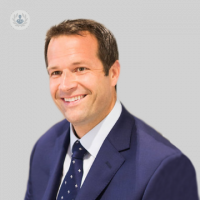Knee arthroscopy: Your questions answered by an expert
Written by:In this informative guide, highly respected consultant orthopaedic surgeon Mr Christopher Arthur Bailey shares his expert insight and guidance for patients preparing to undergo knee arthroscopy. The leading specialist answers commonly asked questions about the procedure, including the associated risks and benefits of this minimally invasive approach, and how it differs from traditional open surgery.

What is knee arthroscopy, and how does it differ from traditional knee surgery?
Knee arthroscopy, also known as keyhole surgery, is minimally invasive surgery of the knee. It is usually performed through two very small incisions at the front of the knee which allow a camera to be inserted to give a very clear view of the internal anatomy. Specialised surgical instruments can then be inserted to treat many common disorders in all areas of the knee.
Who is a suitable candidate for knee arthroscopy?
Knee arthroscopy can be beneficial for a wide range of patients, from young children to older people. The most common indications for this surgery include the management of cartilage (meniscus) tears, traumatic damage to the lining cartilage and ligament injuries including the anterior cruciate ligament.
What are the potential benefits and risks associated with knee arthroscopy?
Minimally invasive surgery has the advantages of allowing access to all areas of the knee and permitting advanced treatments to be performed whilst encouraging rapid healing and recovery from injury. Advances in technology have allowed excellent visualisation of the joint surfaces and the development of surgical techniques enables complex surgery to be performed with minimal soft tissue trauma.
The risks including wound infection, blood clots, pain and stiffness are minimised as the incisions are small. This means that patients can mobilise soon after surgery and rehabilitation can progress rapidly.
What is the typical recovery process after knee arthroscopy?
Most patients can fully weight bear after surgery. Early mobilisation is encouraged to reduce the risks of joint stiffness and blood clots. Physiotherapy is commenced immediately including range of movement, strengthening and proprioceptive exercises to allow early return to normal day to day tasks and rapid progression to leisure and sporting activities.
It is important to follow advice carefully as over-exertion can slow rehabilitation and cause pain, swelling and stiffness.
Are there any recent advancements or innovations in knee arthroscopy techniques that patients should be aware of?
Many procedures, including cartilage repair, removal of loose bodies and ligament reconstruction can now be performed arthroscopically due to the advances in camera quality, the development of instruments and the advances in surgical techniques.
Suturing devices are commonly used to repair torn meniscus, rather than removing this tissue, with the aim of preserving the shock-absorbing function of the knee. Anterior cruciate ligament reconstruction is now performed through very small incisions allowing excellent access and visualisation of the operative site and early mobilisation and return to function.
If you require knee arthroscopy surgery and wish to schedule a consultation with Mr Bailey to discuss a treatment plan, visit his Top Doctors profile today.


